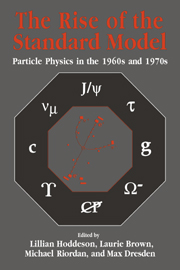Book contents
- Frontmatter
- Contents
- Contributors
- Editors' Acknowledgments
- Photographs of the Symposium
- Abbreviations and Acronyms
- Mathematical Notation
- Part One Introduction
- Part Two Quarks and Leptons
- Part Three Toward Gauge Theories
- Part Four Accelerators, Detectors, and Laboratories
- Part Five Electroweak Unification
- Part Six The Discovery of Quarks and Gluons
- 29 Early Baryon and Meson Spectroscopy Culminating in the Discovery of the Omega-Minus and Charmed Baryons
- 30 Quark Models and Quark Phenomenology
- 31 From the Nonrelativistic Quark Model to QCD and Back
- 32 Deep-Inelastic Scattering and the Discovery of Quarks
- 33 Deep-Inelastic Scattering: From Current Algebra to Partons
- 34 Hadron Jets and the Discovery of the Gluon
- Part Seven Personal Overviews
- Index
29 - Early Baryon and Meson Spectroscopy Culminating in the Discovery of the Omega-Minus and Charmed Baryons
Published online by Cambridge University Press: 03 February 2010
- Frontmatter
- Contents
- Contributors
- Editors' Acknowledgments
- Photographs of the Symposium
- Abbreviations and Acronyms
- Mathematical Notation
- Part One Introduction
- Part Two Quarks and Leptons
- Part Three Toward Gauge Theories
- Part Four Accelerators, Detectors, and Laboratories
- Part Five Electroweak Unification
- Part Six The Discovery of Quarks and Gluons
- 29 Early Baryon and Meson Spectroscopy Culminating in the Discovery of the Omega-Minus and Charmed Baryons
- 30 Quark Models and Quark Phenomenology
- 31 From the Nonrelativistic Quark Model to QCD and Back
- 32 Deep-Inelastic Scattering and the Discovery of Quarks
- 33 Deep-Inelastic Scattering: From Current Algebra to Partons
- 34 Hadron Jets and the Discovery of the Gluon
- Part Seven Personal Overviews
- Index
Summary
The era of studying particle resonance production in the mesonic and baryonic domain was truly exciting and productive. As one looks back, the most important findings occurred in a relatively short time period – roughly 1958–1964, with the preliminaries in the 1950s and lots of details in the 1970s and 1980s. This period of intense activity had many characteristics among which are the following:
1. Accelerators came into their own. Previous productive work occurred in cosmic rays, but now came the Cosmotron, Bevatron, AGS, and PS machines, all contributing important physics results.
2. There was strong interplay between experiment and theory. Global symmetry, the Sakata model, Pais–Piccioni conjecture, Treiman–Yang angle, Jackson angle, Lee–Yang inequalities (and of course, the Gell-Mann–Nishijima, Gell-Mann–Okubo mass formulas), all attest to this close relationship.
3. The early experimental results – even with low statistics – were usually correct. As you will see, the discovery of the ρ, K*, φ, and η just popped out. On the other hand, one had to use some caution, for some of the early indications could be misleading, a case in point being the τ spin-parity, where Robert Oppenheimer cautioned Jay Orear not to bet on horses.
4. As data accumulated, a few incorrect results emerged – some of a major nature, which required large efforts in time and money to correct.
I begin by discussing the Barkas Table, the November 1957 version. It is worth noting that this earliest of compilations is very short – 16 entries.
- Type
- Chapter
- Information
- The Rise of the Standard ModelA History of Particle Physics from 1964 to 1979, pp. 525 - 541Publisher: Cambridge University PressPrint publication year: 1997
- 3
- Cited by



